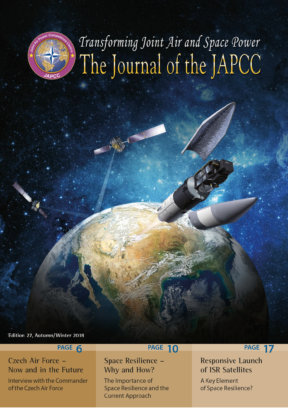Introduction
Since the First World War, the importance of sea-based aviation has evolved, including the increasingly diverse mission sets aircraft carriers provide. Expert opinions on the future effectiveness of air power from the sea have also changed dramatically.1 Decades ago, most experts in the field held the opinion that sea-based air power would be a critical piece of future conflicts, and that global powers should invest heavily in this core, military capability. More recently, many experts’ opinions have changed, stating carriers will be kept from the battlespace due to the rapid increase in the capabilities of Anti-Access/Area Denial (A2/AD) integrated weapon systems.2, 3
Various state-sponsored and non-state actors, utilizing unconventional warfare tactics, pose a plausible threat to the force protection of any naval vessel. However, strategists consider China and Russia as the most likely potential adversaries to have peer capabilities, credibly able to threaten a Carrier Strike Group (CSG). While surface and subsurface systems also pose serious risks to the carrier, the lethality of air threats is growing at an exponential rate. This article will highlight the developments of air threats to aircraft carriers and how future countermeasures might ensure CSG survivability.
Why Own an Aircraft Carrier?
The aircraft carrier’s diverse mission set has been used regularly in conflicts and crises throughout the world over the last 100 years. Diplomacy, power projection, quick crisis response force, land attack from the sea, sea base for helicopter and amphibious assault forces, Anti-Surface Warfare (ASUW), Defensive Counter Air (DCA), and Humanitarian Aid Disaster Relief (HADR) are just some of the missions the aircraft carrier can accomplish.
To help one imagine how a ‘maritime runway’ could accomplish such a diverse number of missions, the 70/80/90 rule-of-thumb is useful: water covers about 70% of the earth’s surface, approximately 80% of the world’s population lives near the ocean, and about 90% of all trade travels by sea. When a crisis occurs on or near a body of water, the aircraft carrier is unique in the speed at which it can arrive, and its independence once on station. Timely responses to emerging conflicts or disasters, even when the arriving force is small in scale, can greatly affect cost and outcome. In many cases, an aircraft carrier is the quickest, most credible military force available.
Too Valuable to Lose?
One of the advantages a carrier has over a traditional airfield is that it can move. Its biggest disadvantage is that an adversary can sink it. With improvements in anti-ship systems worldwide, the probability of losing this capital ship may be increasing. Therefore, in the face of credible threats to an aircraft carrier, pundits often argue that the potential loss of such a high-value asset (as many as 5,500 personnel and 70 aircraft) would be so great that very few scenarios would justify the risk. If so, it begs the question, what are the major threats to the aircraft carrier and what can be done to protect it?
Air Threats to the Aircraft Carrier
Anti-Ship Missiles. Russia has immense anti-ship missile capability and boasts the widest inventory of ballistic and cruise missiles in the world4. One example is the SS-N-26 Anti-Ship Cruise Missile (ASCM), with a 300–450 km range. Russia incorporated it into the land-based K-300P Bastion-P system in 2015, and it contains an active radar and infrared imaging seeker for target determination in the terminal phase. Considering Russian sea-based missiles, the SS-N-27B ‘Sizzler’ is very capable, with a 300 km range and state-of-the-art terminal guidance. It is currently deployed on Russian nuclear submarines and ships, and in September 2017, a submerged submarine fired one into Syria5. The ASCMs that the Russians currently have fielded and employed from the land, sea, and air, are the most capable element of the air component of their defence systems, and pose a significant threat to CSGs.
China has the most active and diverse missile development program in the world6. China’s current Medium Range Ballistic Missile (MRBM), the conventional DF-21D7, entered service in 20068, and has a range of approximately 1500 km, as well as a manoeuvring warhead. In 2016, China announced it had successfully test-launched 10 DF-21Cs9 as a show of military might in response to a potential shift in US policy towards Taiwan and the ‘One China’ stance. China’s next anti-ship ballistic missile will likely be a variant of the DF-26 Intermediate Range Ballistic Missile (IRBM), with a reported range of 3,000–4,000 km, and a nuclear option10. In addition to surface and land-launched anti-ship missiles, aircraft will also be capable of launching ASCMs and Anti-Ship Ballistic Missiles (ASBMs)11, enabling a launch point thousands of kilometres from China. Providing accurate coordinates for a moving target at that range is currently very difficult; however, with future 5th generation platforms and other Chinese targeting sensors, one can assume China will have very long-range, anti-ship capabilities.
Drone Swarms. In the near term, the potential exists that capable adversaries will possess drone swarms able to perform a variety of anti-carrier tactics. According to a detailed UAV study conducted by Project 2049 Institute, ‘The U.S. Navy should have particular concern because, according to several military-technical materials reviewed for this study, People’s Liberation Army operational thinkers and scientists envision attacking U.S. aircraft carrier battle groups with swarms of multi-mission UAVs in the event of conflict’12. These UAVs will be inexpensive and may be transported to the open sea through a variety of methods including submarines, surface ships, or from stealthy UAV ‘mother-ships’. The swarm of UAVs would work in concert, attacking soft targets on the carrier such as personnel, aircraft on the flight deck, ship sensors, and exposed ordnance. A soft-kill of the carrier is also possible by UAVs simply maintaining airborne positions near the carrier, consequently causing a mid-air collision hazard. Additionally, they may attach to the ship and serve as communication relay links, providing ASBM targeting data. In essence, only one’s imagination limits the potential uses of UAVs. They may not sink the carrier, but they can create ways to degrade effective operations. Therefore, carrier defences must be able to eliminate and/or defend against them.
Allied Maritime Counter Air Systems
In light of air threat system improvements, several Allied nations are researching a wide range of future defensive capabilities.
Deployable Lasers. Shipboard lasers likely will be a significant component of ship defence in the near future. In February 2018, the US Navy awarded Lockheed Martin Aculight a $150 million contract to develop a deployable laser, called High Energy Laser and Integrated Optical-dazzler with Surveillance (HELIOS), for the Navy to integrate into resident systems on surface vessels. ‘We’ve now reached the point in laser development [where] you can have effect on the adversary and the adversary’s systems at an operationally important range’, says Rear Admiral Druggan, Commander of the Naval Surface Warfare Center13. Engineers designed the HELIOS system to defeat UAVs and ‘dazzle’ incoming missiles and surface contacts, defeating their homing guidance. Lasers designed for hard-kills should be available within a decade, and will provide self-defence against ASCMs and ASBMs, including Manoeuvring Re-entry Vehicles (MaRVs)14. Even at today’s power levels, the ability of the HELIOS system to defeat UAVs and dazzle incoming missiles will indirectly improve a CSG’s missile defence by reducing the number of engagements that have to be met with the limited supply of standard missiles.
Electromagnetic Rail Gun and Hypervelocity Projectiles. In 2005, the US Navy began funding research for an Electromagnetic Rail Gun (EMRG)15, a cannon able to launch hypervelocity projectiles (HVP) at speeds of 4,500 to 5,600 mph16. Although engineers originally developed the EMRG as a Naval Surface Fire Support (NSFS) weapon, it has promising potential for ship defence against ASCMs and ASBMs. Current prototypes have fired projectiles at energy levels of 20–32 megajoules, enough energy to launch projectiles 50–100 nm. The unguided projectile is designed to engage ASCMs and ASBMs once the missiles arrive in the vicinity of the ship. Due to technical issues, EMRG development has been slow, and some predict operational capability will not occur for a decade or more. With delays to the EMRG system, the US Navy is shifting its focus to employing HVPs from existing 5-inch and 155 mm powder guns17. When a powder gun fires the HVP, it only achieves a speed of approximately Mach 3, but that is still twice the speed of conventional 5-inch shells, and will greatly expand the anti-air engagement options against current and emerging threats, including ASCMs18.
Surface-to-Air Missiles. Naval Integrated Fire Control-Counter Air19 (NIFC-CA) is the newest sea-based Integrated Air and Missile Defence (IAMD) system employed by Allied forces. NIFC-CA is a networked IAMD system utilizing extended target detection and tracking from various sensors, including 5th generation platforms and the Aegis Weapon System. Furthermore, the SM-6 – the newest and most capable multi-purpose missile to date – is included in NIFC-CA, and it is an outstanding new contributor to IAMD at sea. In August 2017, a pair of SM-6 surface-to-air missiles destroyed a MRBM in the terminal phase. A very versatile missile, the SM-6 has demonstrated an ability to target aircraft, cruise missiles, ships, and most recently, ballistic missiles.
The SM-3 also can defend the CSG from ASBMs. A dedicated ballistic missile interceptor, the SM-3 is designed to intercept ballistic missiles during the midcourse of their flight profile. The newest of this series of missiles, the SM-3 Block IIA Ballistic Missile Defence (BMD) interceptor, with an unclassified range of 2,500 km, receives target cueing from many sources, including satellites, and is capable of ‘engage-on-remote’20. In addition to Aegis ships fielding the SM-3 Block IIA missiles, the US Navy plans to deploy these missiles to Aegis Ashore sites, including Redzikowo, Poland21. ‘We will continue developing ballistic missile defense technologies to stay ahead of the threat as it evolves’ said US Air Force Lieutenant General Sam Greaves, Director of the Missile Defense Agency (MDA)22.
The Best Defence is a Good Offence
Another option to increase survivability is to create long-range offensive weapons, enabling the CSG to remain outside of the A2/AD environment23. Continued improvements in surface and maritime air-launched weapons, such as hypersonic missiles, are imperative to accomplish this. Air-launched supersonic missiles have an approximate range of up to 500 km, only marginally more than the S-400’s current reported range of 400 km. Air-launched hypersonic missiles, however, could cover a range of approximately 1,000 km, keeping the launch platform outside the envelope of threat systems. Industry experts are on pace to attain operational readiness of air-launched, hypersonic cruise missiles within 20 years,24 and these could be critical in disabling systems creating an A2/AD environment.
Long-range strikes carried out by stealth aircraft will also be paramount. Combining the F-35’s long combat radius of over 600 nm25 with carrier-launched unmanned air-to-air refuelling aircraft26, the aircraft carrier would be able to perform long-range strike missions with a range up to 1,000 nm. Additionally, F-35s have the ability to obtain target locations of key A2/AD nodes while operating inside threat envelopes, then pass them to systems operating outside threat envelopes27 that can engage the targets.
Conclusion
The capabilities of the next generation CSG will be essential in the event of peer conflict. It will provide robust maritime air power and contribute to the IADS network through state-of-the-art airborne early warning28, 5th and 4th+ generation fighters, and missile defence ships operating advanced versions of the Aegis Weapons System. While air threats to the CSG are becoming increasingly capable, if the Alliance invests in the right defensive (and offensive) capabilities, the CSG will survive against a peer adversary, and remain a viable, valuable asset in the Joint Force Commander’s portfolio.












